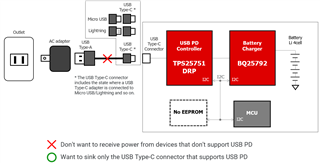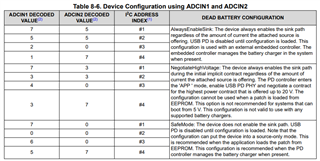Other Parts Discussed in Thread: BQ25792,
Tool/software:
Dear Sirs and Madams,
We are considering using a combination of TPS25751 and BQ25792.
For our application, we do not want to charge the battery when a USB Type-C connector is connected, which does not support USB PD.
So, We found the setting "Do not detect legacy chargers" in the "Enable charging detection" section.

Can We disable charging from an AC adapter connected with a USB TypeA to Type-C cable such as BC1.2 by using this function?

Does "Legacy Chargers" mean 5V/1.5A in general such as BC1.2?
We also don't want to receive power when connecting a USB Type-C adapter to a lightning connector that supports Apple Charge.
The same applies when connecting a USB Type-C connector adapter to a micro/mini USB connector.
Regards,
Masashi




